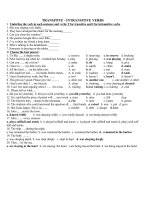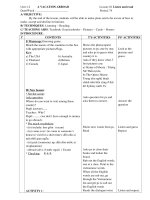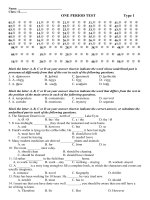- Trang chủ >>
- Sư phạm >>
- Sư phạm toán
E 12 Unit 3
Bạn đang xem bản rút gọn của tài liệu. Xem và tải ngay bản đầy đủ của tài liệu tại đây (85.46 KB, 3 trang )
<span class='text_page_counter'>(1)</span><div class='page_container' data-page=1>
<b>Choose the word which is stressed differently from the rest.</b>
<b>1.</b> A. attract B. person C. signal D. instance
<b>2.</b> A. verbal B. suppose C. even D. either
<b>3.</b> A. example B. consider C. several D. attention
<b>4.</b> A. situation B. appropriate C. informality D. entertainment
<b>5.</b> A. across B. simply C. common D. brother
<b>Choose A, B, C, or D that best completes each unfinished sentence.</b>
<b>6.</b> She is a kind of woman who does not care much of work but generally _______ meals, movies or late
nights at a club with her colleagues.
A. supposes B. discusses C. attends D. socializes
<b>7.</b> I didn't think his comments were very appropriate at the time.
A. correct B. right C. suitable D. exact
<b>8.</b> You should _______ more attention to what your teacher explains.
A. make B. get C. set D. pay
<b>9.</b> Body language is a potent form of _______ communication.
A. verbal B. non-verbal C. tongue D. oral
<b>10.</b>Our teacher often said, "Who knows the answer? _______ your hand."
A. Rise B. Lift C. Raise D. Heighten
<b>11.</b>This is the instance where big, obvious non-verbal signals are appropriate.
A. matter B. attention C. place D. situation.
<b>12.</b>They started, as _______ gatherings but they have become increasingly formalized in the last few years.
A. informal B. informally C. informalize D. informality
<b>13.</b>Children who are isolated and lonely seem to have poor language and ________.
A. communicate B. communication C. communicative D. communicator
<b>14.</b>The lecturer explained the problem very clearly and is always _______ in response to questions.
A. attention B. attentively C. attentive D. attentiveness
<b>15.</b>Pay more attention _______ picture and you can find out who is the robber.
A. to B. for C. at D. on
<b>16.</b>She looked _______ me, smiling happily and confidently.
A. on B. over C. forward to D. at
<b>17.</b>- What an attractive hair style you have got, Mary! - _______
A. Thank you very much. I am afraid B. You are telling a lie
C.Thank you for your compliment D. I don't like your sayings
<b>18.</b>In _______ most social situations, _______ informality is appreciated.
A. Ø / Ø B. the / an C. a / the D. the / a
<b>19.</b>- What_______ beautiful dress you are wearing! - Thank you. That is _______ nice compliment.
A. Ø / Ø B. the / Ø C. a / a D. the / the
<b>20.</b>______ you wanted to ask your teacher a question during his lecture, what would you do?
A. As B. As if C. Even of D. suppose
<b>21.</b>John asked me _______ in English.
A. what does this word mean B. what that word means
C. what did this word mean D. what that word meant
<b>22.</b>The mother told her son _______ so impolitely.
A. not behave B. not to behave C. not behaving D. did not behave
<b>23.</b>She said she _______ collect it for me after work.
A.would B. did C. must D. had
<b>24.</b>She said I _______ an angel.
A. am B. was C. were D. have been
<b>25.</b>I have ever told you he _______ unreliable.
</div>
<span class='text_page_counter'>(2)</span><div class='page_container' data-page=2>
<b>26.</b>I told him _______ the word to Jane somehow that I _______ to reach her during the early hours.
A. passing / will try B. he will pass / tried
C. to pass / would be trying D. he passed / have tried
<b>27.</b>Laura said she had worked on the assignment since _______.
A. yesterday B. two days ago C. the day before D. the next day
<b>28.</b>John asked me _______ interested in any kind of sports.
A. if I were B. if were I C. if was I D. if I was
<b>29.</b>I _______ you everything I am doing, and you have to do the same.
A. will tell B. would tell C. told D. was telling
<b>30.</b>John asked me _______ that film the night before.
A. that I saw B. had I seen C. if I had seen D. if had I seen
<b>Error Identification.</b>
<b>31.</b>According to Mehrabian in1971, only 7% of the information we communicate to others depends upon
the words we saying; 93% of that depends on non-verbal communication. (we say)
A. According to B. only 7% C. we saying D. to others
<b>32.</b>Body language is quiet and secret, but most powerful language of all. (the most)
A. most B. and secret C. Body language D. of all
<b>33.</b>Our bodies send out messages constantly and sometimes we do not recognize that we are using many
nonverbal language. (a lot of)
A. would B. did C. must D. had
<b>34.</b>Our understanding and use of non-verbal cues in facial expressions and gestures are familiar to us nearly
in birth. (from)
A. Our understanding B. in facial expressions
C. in D. are familiar
<b>35.</b>A person's body postures, movements but positions more often tell us exactly what they mean. (and)
A. A person's B. exactly C. what D. but
<b>Read the passage carefully and choose the correct answer.</b>
<b>BODY LANGUAGE AND CULTURAL DIFFERENCES</b>
The body language people use often communicates more about their feelings than the words they are
saying. We use body movements, hand gestures, facial expressions, and changes in our voice to
communicate with each other. Although some body language is universal, many gestures are culturally
specific and may mean different things in different countries.
If you want to give someone the nod in Bulgaria, you have to nod your head to say no and shake it to
say yes – the exact opposite of what we do! In Belgium, pointing with your index finger or snapping your
fingers at someone is very rude.
In France, you shouldn’t rest your feet on tables or chairs. Speaking to someone with your hands in
your pockets will only make matters worse. In the Middle East, you should never show the soles of your feet
or shoes to others as it will be seen as a grave insult. When eating, only use your right hand because they
use their left hands when going to the bathroom.
In Bangladesh, the ‘thumbs-up’ is a rude sign. In Myanmar, people greet each other by clapping, and
in India, whistling in public is considered rude.
In Japan, you should not blow your nose in public, but you can burp at the end of a meal to show that
you have enjoyed it. The ‘OK’ sign (thumb and index finger forming a circle) means ‘everything is good’ in
the West, but in China it means nothing or zero. In Japan, it means money, and in the Middle East, it is a
rude gesture.
<b>36.</b>It is mentioned in the passage that many gestures __________.
A. may mean different things in different countries
</div>
<span class='text_page_counter'>(3)</span><div class='page_container' data-page=3>
D. are used in greeting among men and women
<b>37.</b>People nod their head to say no in __________.
A. Belgium B. Bulgaria C. France D. Japan
<b>38.</b>In the Middle East, people do not use their left hands for eating because they use their left hands________.
A. when going to the bathroom B. when preparing the meal
C. to put in their pockets D. to clean their tables and chairs
<b>39.</b>Which of the following is NOT true according to the passage?
A. In France, people shouldn’t rest their feet on tables.
B. In Belgium, snapping your fingers at someone is very rude.
C. In China, the ‘OK’ sign means money
D. In Myanmar, people greet each other by clapping
<b>40.</b>The word “others” in paragraph 3 refers to __________.
A. other people B. other shoes C. other soles D. other feet
<b>Fill in each numbered blank with one suitable word or phrase.</b>
Researchers in communication show that more feelings and intentions are (41)_______ and received
nonverbally than verbally. Mehrabian and Wienerfollowing have stated that only 7% (42)_______ message
is sent through words, with remaining 93% sent nonverbal (43)_______.
Humans use nonverbal communication because:
1. Words have limitations: There are (44)_______ areas where nonverbal communication is more
(45)_______ than verbal, especially when we explain the shape, directions, personalities which are
expressed nonverbally.
<i>2.</i> Nonverbal signal are powerful: Nonverbal cues primarily express inner (46)_______ while verbal
messages deal basically with outside world. [primarily: mainly]
3. Nonverbal message are likely (47)_______ more genuine: because nonverbal behaviors cannot be
controlled as easily as spoken words.
4. Nonverbal signals can express feelings inappropriate to state: Social etiquette/’etiket/ [ nghi thức] limits
(48)_______ can be said, but nonverbal cues can communicate thoughts.
5. A separate communication channel is necessary to (49)_______ send complex messages: A speaker can
add enormously to the complexity of the verbal message through simple nonverbal (50)_______.
<b>41.</b>A. sent B. posted C. mailed D. thrown
<b>42.</b>A. through B. in C. of D. for
<b>43.</b>A. thought B. expressions C. gestures D. postures
<b>44.</b>A. sum B. great deal C. amount D. numerous
<b>45.</b>A. effect B. effective C. effectively D. effectiveness
<b>46.</b>A. feelings B. words C. shows D. sorrows
<b>47.</b>A. be B. being C. to be D. been
<b>48.</b>A. what B. that C. why D. when
<b>49.</b>A. get B. have C. make D. help
<b>50.</b>A. signs B. signals C. sight D. signatures
</div>
<!--links-->









